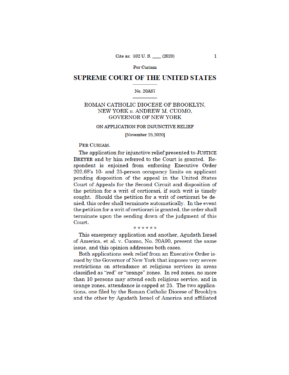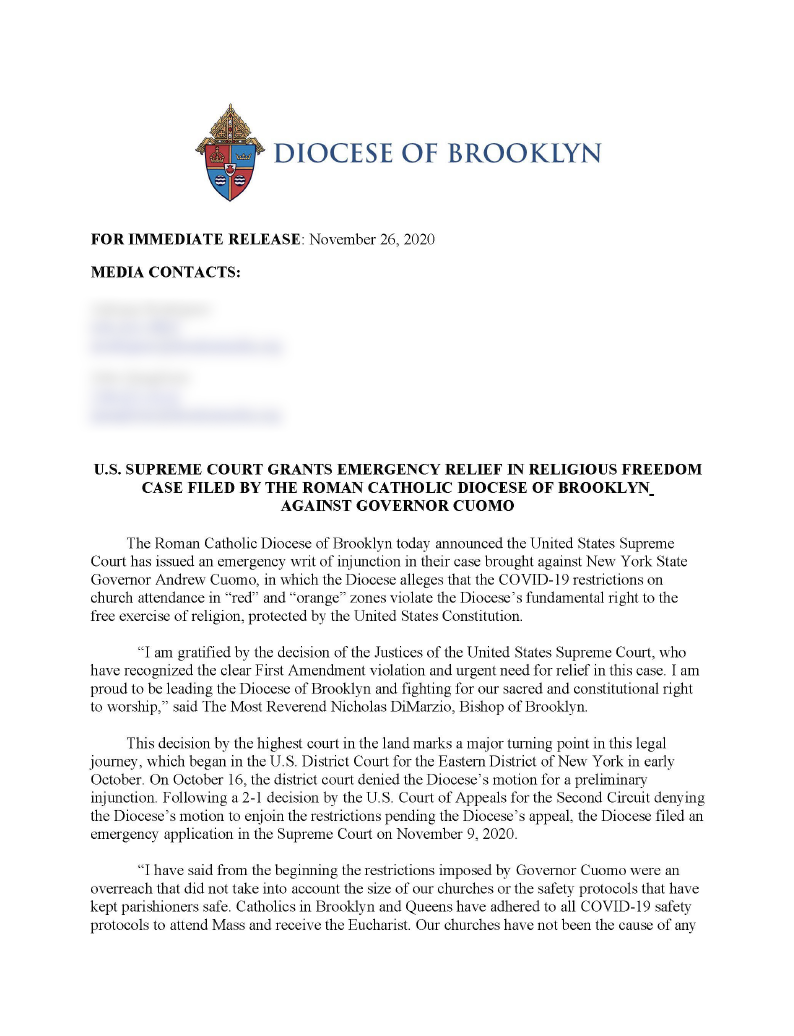The Diocese of Brooklyn received a majority victory Wednesday night when the U.S. Supreme Court ruled that Gov. Andrew Cuomo’s restrictions on attendance at religious services violates the First Amendment.

In a 5-4 decision, the court ruled that Cuomo’s executive order limiting the number of worshipers allowed to attend religious services in houses of worship in COVID-19 hot spots — in some cases as few as 10 people — is a violation of religious freedom.
The court ruled on lawsuits brought by the Diocese of Brooklyn and Agudath Israel of America, an orthodox Jewish organization.
Technically speaking, the court issued an injunction to prevent New York State from enforcing the restrictions.
Technically speaking, the court issued an emergency injunction to prevent New York State from enforcing the restrictions until an appeal is heard in the U.S. Court of Appeals Second Circuit.
In an earlier decision, prior to the Supreme Court getting the case, the Court of Appeals ruled against a request by the diocese for an injunction to be granted immediately. The diocese had been seeking an immediate injunction so that it would be in place while the case is working its way through the court system.
The Court of Appeals agreed to hear arguments on the merits of the injunction request.
The fact that the Supreme Court has stepped in to grant an emergency injunction is a major victory for the diocese, according to officials.
In an unsigned majority opinion, the court acknowledged that the governor’s executive order, issued on Oct. 6, was done in the interests of public safety “but even in a pandemic, the Constitution cannot be put away and forgotten.”

In a statement released Thursday morning by the Diocese of Brooklyn, Bishop Nicholas DiMarzio called the ruling a major victory for religious freedom.
“I am gratified by the decision of the Justices of the United States Supreme Court, who have recognized the clear First Amendment violation and urgent need for relief in this case,” he said. “I am proud to be leading the Diocese of Brooklyn and fighting for our sacred and constitutional right to worship.”
The diocese filed a lawsuit against Cuomo, in his official capacity as governor, on Oct. 8 — two days after he issued his executive order.
Under the order, three zones were created to designate neighborhoods with higher than average COVID-19 rates. Red zones had the strictest attendance rules imposed on them, with a limit of 10 people allowed at a religious service. Orange zones allowed only 25 people, and yellow zones allowed 50 percent capacity.
The Diocese of Brooklyn, which said more than two dozens of its churches in Brooklyn and Queens were located in red and orange zones, charged that the restrictions effectively closed churches.
The Supreme Court agreed.
“There is no question that the challenged restrictions, if enforced, will cause irreparable harm,” the decision read. “There is no justification for this course of action.”
The court also took Cuomo to task for singling out religious institutions for “especially harsh treatment” because commercial businesses were permitted to function with fewer restrictions.
The court also noted that there is “no evidence the organizations that brought the lawsuit contributed to the spike in COVID.”
Bishop DiMarzio argued the restrictions imposed by Cuomo were an overreach.
“We have taken our legal battle this far because we should be considered essential, for what could be more essential than safely gathering in prayer in a time of pandemic,” he said.
In its lawsuit, the diocese outlined the various safety measures it took to ensure parishioners’ safety, including placing its own limits on attendance, the mandatory wearing of masks, and frequent cleaning of churches.
In an opinion concurring with the majority, Justice Brett Kavanaugh wrote that time is of the essence.
“Moreover, issuing the injunction now rather than a few days from now not only ensures that the applicant’s Constitutional rights are protected, but it also provides some needed clarity for the state and religious organizations,” Kavanaugh wrote.
Litigation attorney Randy M. Mastro of the law firm Gibson Dunn s representing the Diocese of Brooklyn.
“Bishop DiMarzio has been a profile in courage, committed to reopening Brooklyn’s churches, safely, and keeping them open,” said Mastro. “So this is a great victory for the Diocese’s churches, but it is also a victory for all people of faith whose rights have now been vindicated.”
The New York State Catholic Conference, which represents the bishops of the state, said that although the restrictions were unfairly harsh, it will continue to be a proactive partner with officials to prevent the spread of the virus.
“That will continue, as protecting the vulnerable is a pro-life principle. We are proud of the success we have had in keeping our people safe,” said Dennis Poust, director of communications for the NYS Catholic Conference.
According to Mastro, the appeal of the district court’s earlier decision denying preliminary injunctive relief is ongoing in the Second Circuit, with oral argument scheduled for Friday, December 18.
Akiva Shapiro, litigation partner with Gibson and Dunn, called the Supreme Court ruling “a landmark decision for religious liberties in this country.”
Prior to the governor’s Oct. 6 executive order, the diocese had been enforcing strict safety regulations in its churches in an effort to prevent the spread of COVID-19 and those rules are still in place even after the Supreme Court decision.
The diocese’s regulations were put in place in the spring, after a commission appointed by Bishop DiMarzio came up with a set of proposals aimed at safeguarding parishioners and clergy during Masses.
The commission was led by former New York City Office of Emergency Management Commissioner Joseph Esposito.
Under the diocese’s regulations, churches operate at 25 percent capacity. Social distancing will be strictly enforced. Rows of pews are blocked off by tape. Everyone who enters church must wear a face mask. Hand sanitizers are located near the entrances of most churches. There are no missals, worship aids or other types of reading materials in the pews.
The regulations also guide certain parts of the Mass. There is no Handshake of Peace among the congregation. Holy Communion is distributed in the hand, not on the tongue and there is currently no distribution of the Precious Blood.
There is no entrance procession. The music ministry is limited to the organist and a cantor who must practice social distancing. The cantor does not sing from the same place from which the lector reads.
Following the Supreme Court ruling, Cuomo insisted that the court’s decision had no practical effect, since he had already lifted the most stringent restrictions on attendance at religious services when he converted red and orange zones to yellow zones in Brooklyn and Queens weeks earlier. Houses of worship in yellow zones are permitted to operate at 50 percent capacity.
“It’s irrelevant of any practical impact because of the zone they were talking about is moot. It expired last week. It doesn’t have any practical effect,” the governor said in a conference call with reporters on Thanksgiving Day.
“The lawsuit was about the Brooklyn zone. The Brooklyn zone no longer exists as a red zone. That’s mooted. So that restriction is no longer in effect. That situation just doesn’t exist because those restrictions are gone,” Cuomo added.
Shapiro said, however, that the court ruling is significant, even though the 10-person limit is gone. The restriction “could snap back at any point in time,” he told The Tablet.
This story has been updated.
